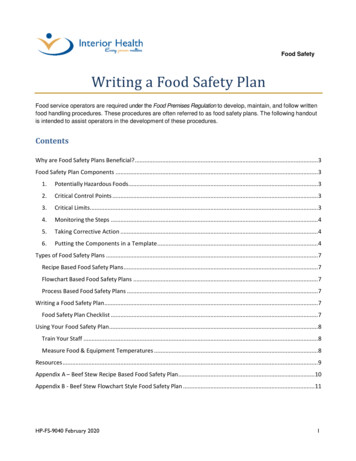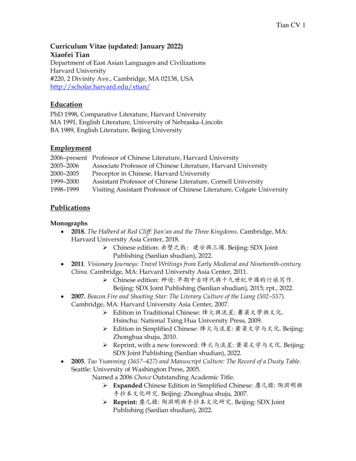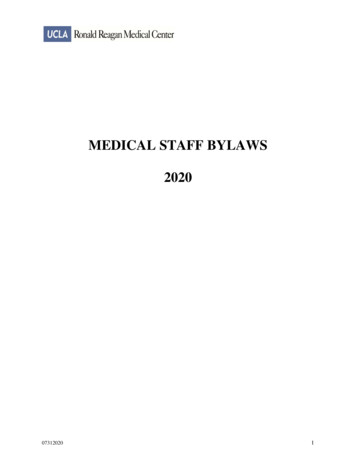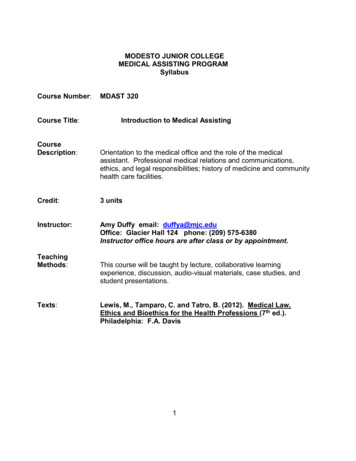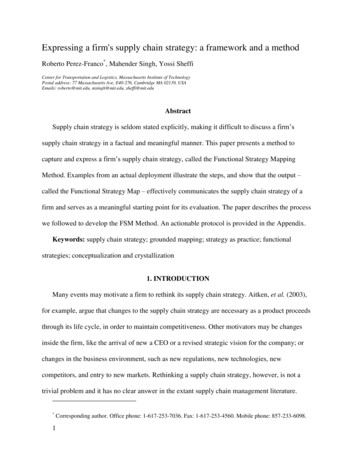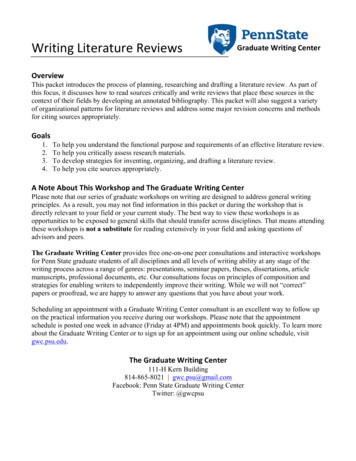
Transcription
Critical Review of MedicalLiteratureIrina Burd, MD, PhDMaternal Fetal MedicineJohns Hopkins University
Is the study valid? Research question Population Intervention Analysis
What is the researchquestion? Is there a well stated hypothesis? Does it include a clinically meaningful andrelevant outcome? What is the end point? Real Surrogate end point biomarker that is intended tosubstitute for a clinical end point Usually used when outcome is rare, long time to observe theoutcome, difficult to measure outcome, rapid disseminationof new treatment such as Phase II and III trials
Is the study valid? Research question Population Intervention Analysis
What is the study sample? Population sample FLOW CHART/Figure 1 available and clear Table 1 is available to describe the sample Is sample representative of source population? Is sample/population representative of population ingeneral Is inclusion and exclusion criteria well stated? ULTIMATELY, “CAN I USE THIS STUDY AND APPLY TO MYPOPULATION?”
Is the study valid? Research question Population Intervention Analysis
InterventionWhat kind of study is this? Case seriesCase controlCohortRandomized control study
Is the study valid? Research question Population Intervention Analysis
Analysis Is there a right analysis for the data available– Power– Multiple comparisons
Is power analysis for the comparisonof groups necessary and is it done? Power analysis– Beta, the Type II error rate, must be kept low– Power which is equal to 1 - beta, must be keptcorrespondingly high– Ideally, power should be at least 0.80 to detect areasonable departure from the null hypothesis.
ResultsUnivariate analysisFrequency tables (usually, Table 1)Bivariate2 by 2 tables (Sensitivity, Specificity, PPV,NPV)Time to eventKaplan Meier analysisMultivariateDepends on type of data:Binary – Logistic regressionContinuous - Linear regression/analysis ofvarianceTime to event: Cox proportional hazardsmodels
Calculation of effect size Relative risk– Estimates the magnitude of association betweenexposure and disease in exposed relative tounexposed Odds ratio– Ratio of odds of exposure among cases to odds ofexposure among controls When to use one versus the other?
Relative risk (RR)DiseaseNo diseaseExposureabNo exposurecdRR Risk of disease in exposedRisk of incidence of disease in unexposed a/(a b)c/(c d)RR 1 There is no association between exposure and disease stateRR 1 There is an increased risk of disease in exposedRR 1 There is a decreased risk of disease in exposed
Odds ratioDiseaseNo diseaseRisk factor presentabRisk factor absentcdOR adbcOR 1 The events are equally likely in 2 groupsOR 1 Event is more likely in one groupOR 1 Event is less likely in one group
How large is the treatment effect Risk without therapy– Baseline risk X Risk with therapy YAbsolute risk reduction X-YRelative risk Y/XRelative risk reduction [(X-Y)/X]/100
BIAS What is bias? Are different biases considered?– Selection bias, including: Sampling bias is systematic error due to a non-random sample of a population, causing somemembers of the population to be less likely to be included than others, resulting in a biasedsample Time interval/length time bias– Analyzing the lengths of intervals by selecting intervals that occupy randomly chosen points in timeor space, a process that favors longer intervals Attrition bias is a kind of selection bias caused by attrition (loss of participants), discountingtrial subjects/tests that did not run to completion. It includes dropout, non-response ,withdrawal and protocol deviators. Therefore, looking at the proper follow up is important– Lead-time bias is the bias that occurs when two tests for a disease are compared, and one test (the new,experimental one) diagnoses the disease earlier, but there is no effect on the outcome of thedisease-- it may appear that the test prolonged survival, when in fact it only resulted inearlier diagnosis when compared to traditional methods– Observer bias Researcher unconsciously influences the participants of an experiment. It is a significantthreat to a study's internal validity and is therefore typically controlled by using a doubleblind experimental design– Recall bias In surveys
Is it a diagnostic testing or a screeningquestion?
Key Concept Sensitivity– The proportion of people who truly have a designateddisorder who are so identified by the test.– Sensitive tests have few false negatives.– When a test with a high Sensitivity is Negative, iteffectively rules out the diagnosis of disease: SnNout.
Key Concept Specificity– The proportion of people who are truly free of adesignated disorder who are so identified by the test.– Specific tests have few false positives.– When a test is highly Specific, a Positive result can rule inthe diagnosis: SpPin.
Key Concepts– Negative predictive value The probability that the disease is not present given anegative test– Positive predictive value The probability that the disease is present given apositive test
Key Concept Likelihood Ratio– Relative likelihood that a given test would be expected in apatient with (as opposed to one without) a disorder ofinterest.LR probability (%) of a test result in patients WITH diseaseprobability (%) of the test result in patients WITHOUT disease
How Do I Use the LR?
Importance What likelihood ratios were associated with therange of possible test results?– How much will different levels of the diagnostic testraise or lower the pretest probability of disease?
What likelihood ratios were associated with the rangeof possible test results?
Importance
Is it a study on prognosis ofdisease?
Key concepts Prognosis– Possible outcomes of a disease and the frequencywith which they can be expected to occur Survival curve– A curve that starts at 100% of the studypopulation and shows the population still surving(or free of disease) at successfuk times for as longas the information is avilable
Survival curve
Key concept Hazard ratio (time to an event rather than anevent itself)– A hazard is the instantaneous risk of an event at agiven point– hazard ratio can be an estimate of relative risk Interpreting hazard ratios– HR 1 is protective– HR 1 is risk factor In survival analysis, HR is the effect of onevariable on the hazard or risk of an event
Key concept Cox Hazard model– Estimate of the treatment effect on survival afteradjustment has been made for other variables– It allows for an estimation of the hazard or a riskof death (or another event of interest), given thepatient’s prognostic variables
Is it a treatment question?
Key concepts– Relative risk reduction Ratio of risk in exposed subjects divided by the risk inunexposed subjects– Number needed to treat The number of patients who need to be treated over aspecific period of time to prevent one bad outcome
When looking at results Consider how precise are the estimates– how wide are the confidence intervals
Applicability Will the reproducibility of the test result and itsinterpretation be satisfactory in my clinical setting?– Does the test yield the same result when reapplied bythe same observer (intraobserver variability)?– Do different observers agree about the test result(interobserver variability)?
Applicability Are the results applicable to the patients in mypractice?– Does the test perform differently (different LRs) fordifferent severities of disease?– Does the test perform differently for populations withdifferent mixes of competing conditions?
Applicability Will the reproducibility of the test result and itsinterpretation be satisfactory in my clinical setting?– Difference between validity and reliability
Themes in the Medical Literature How do we use the medical literature?– Browsing– Problem Solving– Background and Foreground Questions
Clinical Questions Clinical Population - Study Population Intervention/Outcomes - Methods Results - Clinical Population
Population– What barriers exist to going from a clinicalpopulation to a study population?– How can we ensure that the study populationrepresents the true population of interest?
Therapy Study–––Did intervention and control groups start with the sameprognosis?What were the inclusion / exclusion criteria?Where did recruitment occur?
Diagnostic Test Does the sample of patients represent the full spectrum of patients with andwithout the diagnosis of interest?Did participating patients present a diagnostic dilemma? – Were subjects drawn from a group in which it is not known whether the condition ofinterest is present or absent?Does pre-test probability fall between test and treatment thresholds?
Prognosis Study Is the cohort representative of a defined group or population?–– Referral bias, failure to clearly define study patientsMust report implicit filters passed before entering the study. Describeinclusion/exclusion criteria.Were the patients sufficiently homogenous with respect to prognostic risk?–Patients should be at similar point in disease process.
Other Considerations Qualitative Study– Were participants relevant to the researchquestion?– Was participant selection well reasoned?– Did selection criteria evolve over the course ofsampling after investigators returned to the datato explore new ideas?
Interventions/Exposures/Outcomes What considerations should we apply tomethods and results?
Therapy Study–Did intervention and control groups start with the same prognosis? –Was prognostic balance maintained during study? –Were participants, researchers, and outcome assessors blinded to group allocationthroughout?Was prognostic balance maintained at study completion? –Were patients randomized?Was randomization concealed?Were patients in the treatment and control group similar with respect to known prognosticvariables?Was follow-up complete?ITT analysis?Was trial stopped early?
Diagnostic Test Did investigators compare the test to an appropriate, independent reference standard?––– Was the reference standard acceptable?Were the test and standard independent?Were the test and standard results assessed blindly?Were those interpreting the test and reference standard blind to the other results?– Is the test result interpretation subjective? Expectation bias?Did investigators perform the same reference standard to all patients regardless of theresults of the test under investigation?–Was a different reference standard applied to subjects testing negatively?
Cost-Effectiveness Study What viewpoint is used to evaluate costs and consequences(patient, hospital, third-party payer, or society at large)? What outcomes are being compared?Are costs or chargesbeing evaluated? Where are estimates coming from and are they realistic? Did investigators adopt a sufficiently broad viewpoint? Are results reported separately for patients whose baselinerisks differ? Were costs measured accurately? Did investigators consider the timing of costs andconsequences?
Qualitative Study Is data collection comprehensive? Iterativedata collection and analysis? Were the data appropriately analyzed and thefindings adequately corroborated? Was theoretical saturation achieved and diddata collection and analysis yield meaningfuldescriptions of social phenomena?
Therapy Study–––How large was the treatment effect?How precise was the estimate of the treatment effect?How can I apply the results to patient care? Study patients similar to my patient?Were all patient important outcomes considered?Are the likely treatment benefits worth the potential harms andcosts?
Diagnostic Test Will the reproducibility of the test result and its interpretation be satisfactory in mysetting?– Are the results applicable to my patients?Will the results change my management?–– What are the test and treatment thresholds for the health condition to be detected?Are the test LRs high or low enough to shift posttest probability across a test or treatmentthreshold?Will the patients be better off as a result of the test?– Consider if test has intraobserver or interobserver variability?Will patient care or outcomes differ for different test results?Will anticipated changes do more harm than good?
Prognosis Study How large is the likelihood of the outcomes events in specified time period?How precise are the estimates of likelihood?Were the study patients and their management similar to those in my practice?Was the follow-up sufficiently long?Can I use the results in the management of patients in my practice?
Qualitative Study How evocative and thorough is the description? Does the datatell a story? Is the theory comprehensive, coherent, and appropriate? What are the concepts included in the theory? Does it make sense? Are concepts well developed? Does it fit with what we understand about the field?Are theresults relevant? Do results in a report help each party (investigator, patient,reader) make sense of a social phenomena? Does this study teach me something that will help meunderstand my patients differently? Will it change my interactions in similar clinical situations inthe future?
Surrogate Endpoints Is there a strong, independent, consistent relationshipbetween the surrogate endpoint and the clinical endpoint? Strength of the study design: Relative Risk vs Odds Ratio,Cohort vs Case controlled study Is there evidence from other trials that improvement in thesurrogate end point has consistently led to improvement inthe target outcome? Is this population similar to the population I take care of? Are the likely treatment benefits worth the potential harmand costs? Overtreatment is not without risk
Screening What are the benefits?– Absolute risk reduction, Relative risk reduction, Number needed to treat What are the harms?––––– complications arising from investigation (screening test);adverse effects of treatment;adverse effects of labeling and early diagnosis;anxiety generated by the investigations and treatment; andcosts and inconvenience incurred during investigations and treatment.How do benefits and harms compare in different people and with differentscreening strategies?– Risk of disease (Benefits change with risk of disease – eg age)– Screening interval – time sensitive– Test characteristic What is the effect of individuals' values and preferences? – Patient decision aids - Provide high quality balanced information about difficult decisions– Examples – Down Syndrome; Commercial drivers – strong economic incentivesWhat is the effect of uncertainty associated with the evidence?
Critical Review of Medical Literature Irina Burd, MD, PhD Maternal Fetal Medicine Johns Hopkins University . Is the study valid? Research question Population . – Will patient care or outcomes differ for different test re


